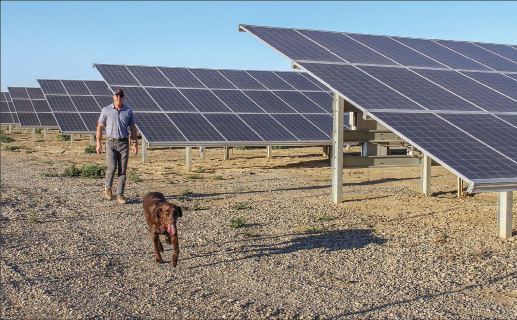Mar 17, 2022Farmers remain key to California’s renewable energy future
California is progressing toward its goal of achieving 100% renewable and carbon-neutral electricity by 2045, and agriculture may be an integral part of the solution.
Farmers statewide have invested in renewable-energy technologies near vineyards, row-crop farms and atop walnut dryers. According to the U.S. Department of Agriculture, 8% of California farms have an on-site renewable-energy system.
Aaron Barcellos, who farms row crops and trees in Merced and Fresno counties, took advantage of federal tax incentives and invested in constructing two solar systems that total 1.4 megawatts to offset the farm’s energy usage.
“Most farmers, if they’ve got a drip system with an electric pump on it, are probably spending between $80 and $120 an acre per year at least on just their energy costs, depending on the crop and how much water they’re delivering,” Barcellos explained. “On-farm energy use is definitely a big deal. It’s one of those line items in the budget that we always check on.”
With the ongoing drought and a regulation that requires local agencies to balance groundwater supplies under the Sustainable Groundwater Management Act, or SGMA, more farmers see renewable energy as a source of income, especially with farmland expected to go out of production.
“Right now, agriculture has a huge role to play, especially with SGMA,” Barcellos said. “We know we’re going to be retiring lands that don’t have enough water, and there’s lots of interest in solar for those.”
Arian Aghajanzadeh, an agriculture technology expert who founded Klimate Consulting in San Francisco, said farmers have a unique role to play in California’s energy future.
“Agriculture and land use is the only sector of the economy that can transition from becoming a major source of carbon emissions to becoming a major carbon sink” in reducing emissions, Aghajanzadeh said. “No other sector can achieve this.”
The state’s electricity mix is already more than 60% carbon free. About 36% of that comes from renewable sources, predominantly solar and wind.
Solar arrays dominate the on-farm growth of energy systems due in part to incentives provided by a federal tax credit. And, under California power-generation policies, solar customers who produce their own energy can receive financial credits for unused power their systems provide to the electrical grid.
“With the creation of Net Energy Metering Aggregation, where customers can accumulate multiple accounts and offset them against a single renewable generating facility, farmers and ranchers have been able to create sustainable operations and choose optimum locations for the facility that doesn’t impair their productive acres,” said Karen Norene Mills, California Farm Bureau director of legal services.
The California Public Utilities Commission has been considering rolling back long-term financial benefits that purchasers of solar power have counted on under the net-metering program.
An issue in PUC proceedings is whether the program will retain, cut back or kill a benefit to solar power customers that allows them to sell unused power to utilities for 20 years. Mills said the California Farm Bureau is fully engaged in the matter and is arguing for the current policies to remain intact.
Barcellos said he is worried that “the return on investment window is getting tighter and tighter.”
Specific to water, Aghajanzadeh said irrigation remains very energy intensive for farmers, and the transition from flood to more pressurized irrigation has increased power demands—especially for those who rely more on groundwater due to cuts in surface-water supplies.
But new energy solutions are in the works. One effort, called “Project Nexus,” involves placing solar panels over San Joaquin Valley canals to produce renewable energy, conserve farmland and reduce water evaporation. The project is a partnership among Turlock Irrigation District; University of California, Merced; and others.
“Project Nexus, with 5 megawatts of solar power, will help TID move closer to meeting clean energy goals and allow the district to study the scalability of the project across our 250 miles of canals, which could remove the need for expensive land purchases for large-scale solar projects,” said TID External Affairs Manager Josh Weimer. “As we’re in the midst of a third consecutive dry year, any and all water savings are beneficial to TID and the state.”
Another step, Aghajanzadeh said, is to incentivize farmers to shift irrigation loads from midday hours, when there is excess solar, and make it easier for the grid in the evening.
He said “flexible irrigation” would be more cost effective than storing electricity in batteries. Groundwater storage can also be another form of a battery when water is moved to bolster aquifers so less energy is required to pump it out of the ground, he said.
Barcellos said flexible irrigation and shifting loads is not yet practical for farmers. At times irrigation is running 24/7, and irrigation systems would have to be redesigned to make this approach more effective, he said.
Solar is another option. Farmers and food processors such as Mann Packing Co., a grower-packer-shipper in the Salinas Valley, are taking advantage of wind energy.
Steve Sherr of Foundation Windpower, which constructed a 1.79 megawatt wind turbine for Mann Packing in Gonzales, said, “Wind also happens to be a particularly valuable resource here in California, as it fills a need for energy generation during times of day when solar is no longer available,” adding that wind requires a limited amount of land.
Related to the state’s energy future, Barcellos said, “Agriculture has a role to play.” He said energy demands may lead to more specialized crops and cost-efficient water systems.
“California farming right now is changing so fast and right in front of our eyes,” he said. “I’m not sure what five years or 10 years from now will look like, but you have to be engaged in just about every space.”
— Christine Souza, California Farm Bureau















